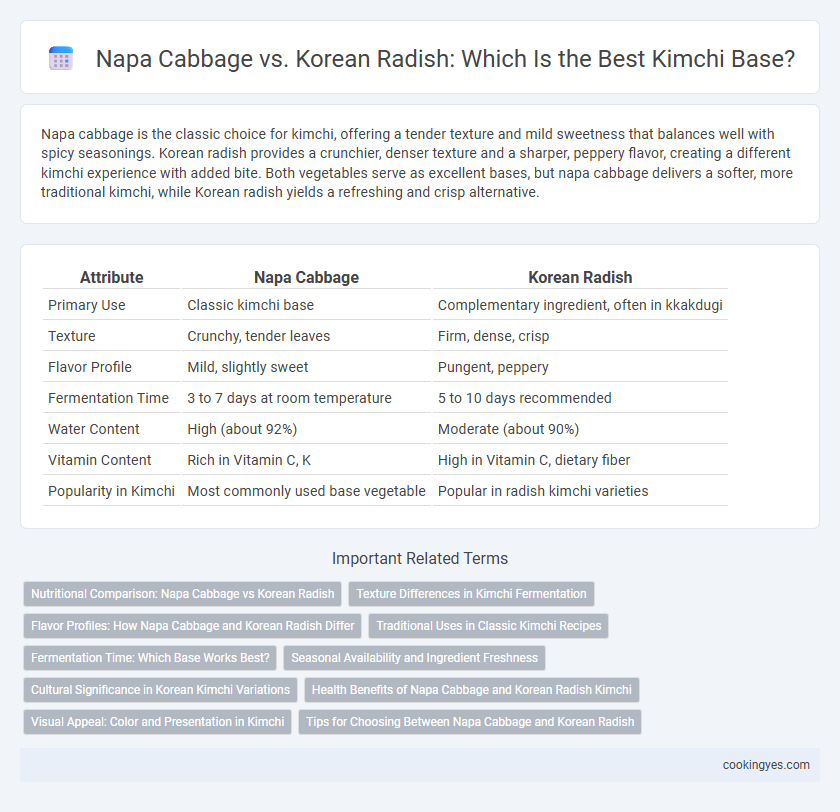Napa cabbage is the classic choice for kimchi, offering a tender texture and mild sweetness that balances well with spicy seasonings. Korean radish provides a crunchier, denser texture and a sharper, peppery flavor, creating a different kimchi experience with added bite. Both vegetables serve as excellent bases, but napa cabbage delivers a softer, more traditional kimchi, while Korean radish yields a refreshing and crisp alternative.
Table of Comparison
| Attribute | Napa Cabbage | Korean Radish |
|---|---|---|
| Primary Use | Classic kimchi base | Complementary ingredient, often in kkakdugi |
| Texture | Crunchy, tender leaves | Firm, dense, crisp |
| Flavor Profile | Mild, slightly sweet | Pungent, peppery |
| Fermentation Time | 3 to 7 days at room temperature | 5 to 10 days recommended |
| Water Content | High (about 92%) | Moderate (about 90%) |
| Vitamin Content | Rich in Vitamin C, K | High in Vitamin C, dietary fiber |
| Popularity in Kimchi | Most commonly used base vegetable | Popular in radish kimchi varieties |
Nutritional Comparison: Napa Cabbage vs Korean Radish
Napa cabbage offers high levels of vitamins A and C, along with dietary fiber, supporting immune health and digestion in kimchi. Korean radish provides significant amounts of vitamin C and potassium, promoting antioxidant benefits and electrolyte balance. Both ingredients contribute distinct nutritional profiles essential for a balanced and flavorful kimchi base.
Texture Differences in Kimchi Fermentation
Napa cabbage-based kimchi offers a crunchy yet tender texture that softens pleasantly during fermentation, making it a popular choice for balanced mouthfeel. Korean radish, by contrast, provides a denser, crispier bite that maintains firmness longer throughout the fermentation process, resulting in a more robust texture. The distinct cellular structure of Napa cabbage allows quicker absorption of seasoning and faster softening, whereas Korean radish's higher fiber content ensures a prolonged crunchy experience.
Flavor Profiles: How Napa Cabbage and Korean Radish Differ
Napa cabbage offers a mild, slightly sweet flavor with a tender texture, creating a balanced base for kimchi fermentation, enhancing umami development. Korean radish provides a crisp, peppery bite with subtle earthiness, lending a sharp brightness and crunch to the kimchi's flavor profile. Combining both ingredients can achieve a complex taste, where the softness of Napa cabbage complements the bold spiciness and freshness of Korean radish.
Traditional Uses in Classic Kimchi Recipes
Napa cabbage is the most traditional and widely used base for classic kimchi recipes, prized for its tender texture and ability to absorb seasoning deeply during fermentation. Korean radish, known as mu, is often incorporated in kimchi varieties like kkakdugi and adds a crunchy texture with a slightly sweet and peppery flavor. Both ingredients are essential in authentic kimchi-making, with napa cabbage providing the primary leafy bulk and Korean radish contributing a refreshing contrast and complexity to the overall taste profile.
Fermentation Time: Which Base Works Best?
Napa cabbage ferments faster than Korean radish, typically reaching optimal kimchi flavor within 1 to 2 weeks due to its high water content and tender leaves. Korean radish-based kimchi requires a longer fermentation period, often 3 to 4 weeks, as its denser texture slows down the fermentation process. For quicker fermentation with a softer texture, Napa cabbage is ideal, while Korean radish suits those seeking a crunchier texture and deeper probiotic development over extended fermentation.
Seasonal Availability and Ingredient Freshness
Napa cabbage, primarily harvested in late autumn, offers a tender texture and mild sweetness ideal for kimchi during cooler months, while Korean radish peaks in freshness during winter and early spring, providing a crisp and dense base with a slightly peppery flavor. Seasonal availability of napa cabbage aligns with traditional kimchi-making times, ensuring optimal freshness and fermentation quality, whereas Korean radish's cooler season harvest preserves its crunch and moisture, making it a preferred choice for certain kimchi varieties like kkakdugi. Selecting between napa cabbage and Korean radish as a kimchi base depends on seasonal freshness, texture preference, and desired fermentation characteristics.
Cultural Significance in Korean Kimchi Variations
Napa cabbage and Korean radish serve as foundational ingredients in kimchi, each embodying distinct cultural significance within Korean culinary traditions. Napa cabbage kimchi, or baechu kimchi, is the most widely recognized variety, symbolizing communal harmony and seasonal change during the kimjang process. Korean radish, or mu, forms the base of kkakdugi and dongchimi, reflecting regional diversity and the importance of fermentation balance in Korean kimchi variations.
Health Benefits of Napa Cabbage and Korean Radish Kimchi
Napa cabbage kimchi is rich in vitamins A, C, and K, along with antioxidants that support immune function and reduce inflammation. Korean radish kimchi offers a high fiber content promoting digestive health and contains enzymes that aid metabolism and detoxification. Both varieties provide probiotics essential for gut health and contribute to cardiovascular well-being through their nutrient profiles.
Visual Appeal: Color and Presentation in Kimchi
Napa cabbage provides a vibrant, leafy texture with pale green and white hues that create a visually striking contrast in kimchi, enhancing its overall presentation. Korean radish contributes a crisp, dense texture and a bright white color that adds a clean, bold visual element to the kimchi base. Combining these ingredients results in a dynamic, colorful appearance that elevates the sensory appeal of the dish.
Tips for Choosing Between Napa Cabbage and Korean Radish
Choosing between Napa cabbage and Korean radish as a kimchi base depends on texture and flavor preferences; Napa cabbage offers a softer, leafy texture with a mild sweetness, while Korean radish provides a crunchier, denser bite with a peppery undertone. For traditional baechu kimchi, Napa cabbage is ideal due to its ability to absorb seasonings and ferment evenly, whereas Korean radish suits kkakdugi or radish kimchi recipes requiring a firmer texture that holds up during fermentation. Selecting fresh, firm Napa cabbage with crisp, green leaves or a dense Korean radish with smooth skin ensures optimal fermentation and flavor development in homemade kimchi.
Napa Cabbage vs Korean Radish for kimchi base Infographic

 cookingyes.com
cookingyes.com